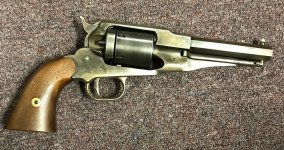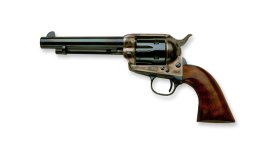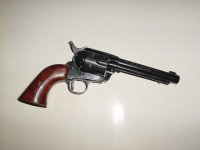I've had (and still have) a number of cap and ball revolvers over the years.
Several observations:
1. I prefer actual FFFg black powder to any of the substitutes. Pyrodex in particular produces a very hard fouling that will start to impede cylinder rotation on a tight fitting revolver after 2-3 cylinders worth of shooting. A wet cloth or dry bushing are in order if that happens.
2. Clean up isn't hard but it does take 15 minutes or so. A bucket of hot water and dish soap, a little scrubbing with a bronze brush, a hot as you can get it tap water rinse long enough to heat the metal to the water temp, then pat it all dry and let the heat do the rest. I try to keep the water out of the holes into the interior of the revolver, and I put a few drops of oil in each when I re-oil the pistol after it is dry. About once or twice a year I break it down for a detailed internal cleaning. Doing this mine have been rust free for decades.
3. I own a pair of 1847 Walker Colts, an Uberti and one of the Colt Signature Series (Uberti parts assembled my Iver Johnson in the US for Colt. Uberti makes great replicas, and the Colt Signature series are as good as it gets.
I also own a few Pietta revolvers - an 1858 Remington, an 1860 Colt Army and and 1851 Navy. Quality varies with the Uberti revolvers depending who ordered them. As someone stated above Cimarron branded replicas are top notch. Pietta revolvers also vary from "ok" to "poor", again depending on the brand. You get what you pay for and at the low end you'll get soft nipples that deform and brittle springs that break.
My first cap and ball revolver was a Ruger Old Army. Modern sights, based on the Super Blackhawk, available in stainless steel it is by far the most practical cap and ball revolver ever made and with 45 grains of powder capacity it's the heaviest hitting revolver, equal to the Colt Dragoons and second only to the Walker Colt. It's not the most traditional, but it is by far the most practical to shoot.
You can also get 1858 Remingtons in stainless as well as in an adjustable sight model and if you can't find an Old Army and want a practical field pistol, that's the route you want to take.
4. Stay away from brass frames, especially in .45 Caliber 1851 revolvers, where the originals were .36 caliber. They look pretty but they won't last.
5. Be aware there are several ".45 caliber" dimensions. You'll find some (usually Pietta) that need a .451" ball, others that need a .454" ball (usually Uberti), and some that need a .457" ball (usually the Colt Walker and 1st through 3rd model Dragoon pistols) and the Ruger Old Army). You absolutely must have a ball that fits the cylinder tight enough so that then you seat it, it cuts a thin ring off the ball all the way around. If not you'll get poor accuracy and potentially a chain fire.
6. Let's talk about chain fires. I hear people attribute this to loose fitting caps, but that's not the cause. The path from one cap out under the nipple, up and over to the next chamber and then up and past the next cap and down into the chamber is so long and convoluted and the spark that might be left doesn't have the heat to ignite the charge. As an example, I have an 1859 Sharps Berdan rifle where the trip down through the block, with a 90 degree turn to the middle of the block and another 90 degree turn to the powder is so long that even a musket cap won't light up a charge of Pyrodex. It's so marginal that it's black powder or nothing. A number 10 or 11 cap lighting up the adjacent cylinder after four 180 degree turns in mostly open air doesn't happen.
What does cause chain fires is loose fitting balls, and the lack of a lubricant over or under the ball. Filling the space between the ball and the cylinder with Crisco or similar grease is the simplest solution and it keeps the powder fouling soft.
Spit Ball does the same, smells better and won't go rancid on you, but both will run in a holster on a hot day if you carry the revolver all day. In that case, using a lubricated felt wad under the bullet works just fine - but it won't keep the powder fouling as soft for an extended shooting session.
7. BP era revolvers have a notch for the hammer between the cylinders where the hammer rests after you load it up so you can load all six. Some folks still will only load 5, but 5 out of 6 of them don't realize the purpose of those notches.
-----
Getting a black powder revolver and a conversion cylinder is the best of both worlds, and it adds a lot of variety with some very interesting pistols and conversions available. But be aware that they are intended for black powder era pressures so stick with standard pressure .45 Colt and .38 Special.
You also still have the option of shooting them with black powder loaded cartridges, and clean up is the same as with a cap and ball revolver.
Colt Signature Series 1847 Walker.






